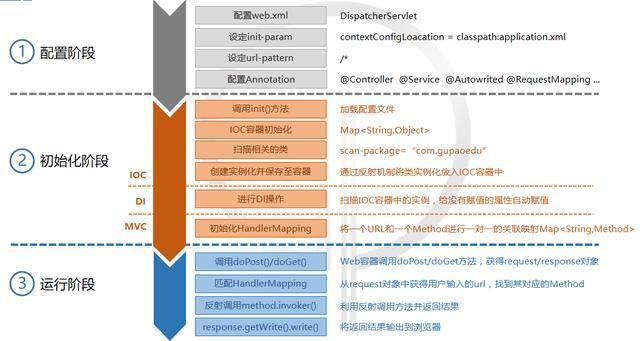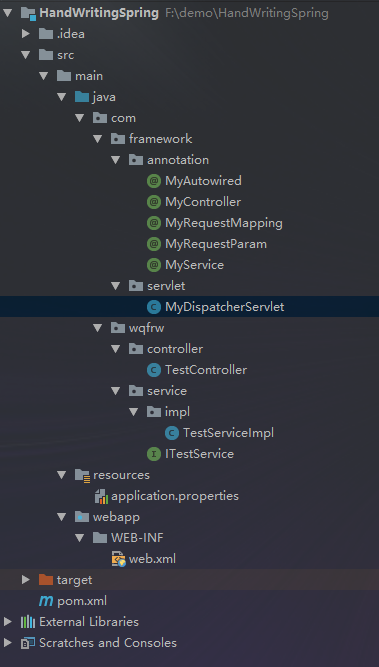前言
Sping的生态圈已经非常大了,很多时候对Spring的理解都是在会用的阶段,想要理解其设计思想却无从下手。前些天看了某某学院的关于Spring学习的相关视频,有几篇讲到手写Spring源码,感觉有些地方还是说的挺好的,让博主对Spring的理解又多了一些,于是在业余时间也按照视频讲解实现一遍SpringIOC、DI、MVC的设计思想,加深巩固记忆,也便于初学者理解,我们不用重复造轮子,但得知道轮子怎么造。
源码放在文章末尾哦~
开发工具
环境:jdk8 + IDEA + maven
jar包:javax.servlet-2.5
实现步骤

视频中这张图画得很好,我们按照这张图来概括一下实现步骤
1.配置阶段:即配置web.xml和application.properties,以及相关自定义注解;
2.初始化阶段:初始化Ioc容器,将扫描到的类实例化交给IoC容器管理,然后注入实例的各属性,接着将请求路径与执行方法的映射加载到HandlerMapping中;
3.运行阶段:由HandlerMapping根据请求路径将请求分发到指定方法,返回执行结果。
附上自己的项目结构供参考

具体实现
配置阶段
application.properties 配置扫描路径,这里为了方便,所以没有使用xml文件去解析
scanPackage=com.wqfrw
web.xml 配置Servlet和application文件的路径
<servlet>
<servlet-name>mymvc</servlet-name>
<servlet-class>com.framework.servlet.MyDispatcherServlet</servlet-class>
<init-param>
<param-name>contextConfigLocation</param-name>
<param-value>application.properties</param-value>
</init-param>
<load-on-startup>1</load-on-startup>
</servlet>
<servlet-mapping>
<servlet-name>mymvc</servlet-name>
<url-pattern>/*</url-pattern>
</servlet-mapping>
pom.xml 引入servlet.jar
<dependency> <groupId>javax.servlet</groupId> <artifactId>servlet-api</artifactId> <version>2.5</version> </dependency>
相关自定义注解
@Target(ElementType.FIELD) @Retention(RetentionPolicy.RUNTIME) @Documented public @interface MyAutowired { String value() default ""; } @Target(ElementType.TYPE) @Retention(RetentionPolicy.RUNTIME) @Documented public @interface MyController { String value() default ""; } @Target({ElementType.TYPE, ElementType.METHOD}) @Retention(RetentionPolicy.RUNTIME) @Documented public @interface MyRequestMapping { String value() default ""; } @Target(ElementType.PARAMETER) @Retention(RetentionPolicy.RUNTIME) @Documented public @interface MyRequestParam { String value() default ""; } @Target({ElementType.TYPE}) @Retention(RetentionPolicy.RUNTIME) @Documented public @interface MyService { String value() default ""; }
初始化阶段
这部分的操作才是最重要的,注释我都详细的写在代码中
MyDispatcherServlet
public class MyDispatcherServlet extends HttpServlet { //IoC容器 private Map<String, Object> ioc = new HashMap<>(); //加载配置文件对象 private Properties contextConfig = new Properties(); //扫描到的类名带包路径 private List<String> classNameList = new ArrayList<>(); //url与方法的映射 也就是请求分发器 private Map<String, Method> handlerMapping = new HashMap<>(); @Override protected void doGet(HttpServletRequest req, HttpServletResponse resp) throws ServletException, IOException { doPost(req, resp); } @Override protected void doPost(HttpServletRequest req, HttpServletResponse resp) throws ServletException, IOException { try { doDispatch(req, resp); } catch (Exception e) { e.printStackTrace(); resp.getWriter().write("500 Exception Detail:" + Arrays.toString(e.getStackTrace())); } } @Override public void init(ServletConfig config) throws ServletException { //加载配置文件 拿到需要扫描的包路径 doLoadConfig(config.getInitParameter("contextConfigLocation")); //扫描相关的类 doScanner(contextConfig.getProperty("scanPackage")); //实例化Bean到IoC容器 doInstance(); //依赖注入(DI) doAutowired(); //初始化HandlerMapping url和对应方法的键值对 doInitHandlerMapping(); //初始化完成 System.out.println("MySpring framework is init!"); } /** * 功能描述: 接收到浏览器的请求,执行方法 * * @创建人: 我恰芙蓉王 * @创建时间: 2020年07月28日 20:54:04 * @param req * @param resp * @return: void **/ private void doDispatch(HttpServletRequest req, HttpServletResponse resp) throws Exception { String url = req.getRequestURI(); String contextPath = req.getContextPath(); url = url.replaceAll(contextPath,""); //根据请求路径如果没有找到对应的方法则抛出404错误 if (!handlerMapping.containsKey(url)) { resp.getWriter().write("404 Not Found!"); return; } Map<String,String[]> params = req.getParameterMap(); Method method = handlerMapping.get(url); String beanName = toLowerFirstCase(method.getDeclaringClass().getSimpleName()); //方法调用 method.invoke(ioc.get(beanName),new Object[]{req,resp,params.get("name")[0]}); } /** * 功能描述: 初始化HandlerMapping * * @创建人: 我恰芙蓉王 * @创建时间: 2020年07月28日 20:56:09 * @param * @return: void **/ private void doInitHandlerMapping() { ioc.forEach((k, v) -> { Class<?> clazz = v.getClass(); //加了MyController注解的类才操作 if (clazz.isAnnotationPresent(MyController.class)) { String baseUrl = ""; //如果类上面加了MyRequestMapping注解,则需要拿到url进行拼接 if (clazz.isAnnotationPresent(MyRequestMapping.class)) { MyRequestMapping annotation = clazz.getAnnotation(MyRequestMapping.class); baseUrl = annotation.value(); } //获取所有public修饰的方法 Method[] methods = clazz.getMethods(); //过滤拿到所有MyRequestMapping注解的方法,put到handlerMapping中 String finalBaseUrl = baseUrl; Stream.of(methods) .filter(m -> m.isAnnotationPresent(MyRequestMapping.class)) .forEach(m -> { MyRequestMapping annotation = m.getAnnotation(MyRequestMapping.class); String url = (finalBaseUrl + annotation.value()).replaceAll("/+", "/"); handlerMapping.put(url, m); }); } }); } /** * 功能描述: 依赖注入(DI) * * @创建人: 我恰芙蓉王 * @创建时间: 2020年07月28日 20:55:57 * @param * @return: void **/ private void doAutowired() { //循环IoC容器中所管理的对象 注入属性 ioc.forEach((k, v) -> { //拿到bean所有的字段 包括private、public、protected、default Field[] Fields = v.getClass().getDeclaredFields(); //过滤拿到所有加了MyAutowired注解的字段并循环注入 Stream.of(Fields) .filter(f -> f.isAnnotationPresent(MyAutowired.class)) .forEach(f -> { MyAutowired annotation = f.getAnnotation(MyAutowired.class); String beanName = annotation.value().trim(); if ("".equals(beanName)) { beanName = f.getType().getName(); } //强制访问 f.setAccessible(true); try { //赋值 f.set(v, ioc.get(beanName)); } catch (IllegalAccessException e) { e.printStackTrace(); } }); }); } /** * 功能描述: 实例化bean至IoC容器 * * @创建人: 我恰芙蓉王 * @创建时间: 2020年07月28日 20:55:39 * @param * @return: void **/ private void doInstance() { classNameList.forEach(v -> { try { Class<?> clazz = Class.forName(v); //只初始化加了MyController注解和MyService注解的类 if (clazz.isAnnotationPresent(MyController.class)) { String beanName = toLowerFirstCase(clazz.getSimpleName()); ioc.put(beanName, clazz.newInstance()); } else if (clazz.isAnnotationPresent(MyService.class)) { // 1.默认首字母小写 String beanName = toLowerFirstCase(clazz.getSimpleName()); // 2.自定义beanName MyService myService = clazz.getAnnotation(MyService.class); if (!"".equals(myService.value())) { beanName = myService.value(); } // 3.如果是接口 必须创建实现类的实例 for (Class<?> i : clazz.getInterfaces()) { if (ioc.containsKey(i)) { throw new Exception("This beanName is exists!"); } beanName = i.getName(); } //将实例化的对象放入IoC容器中 ioc.put(beanName, clazz.newInstance()); } } catch (Exception e) { e.printStackTrace(); } }); } /** * 功能描述: 扫描相关的类 加入到classNameList * * @创建人: 我恰芙蓉王 * @创建时间: 2020年07月28日 20:55:10 * @param scanPackage * @return: void **/ private void doScanner(String scanPackage) { //获取根目录 拿到com.wqfry替换成/com/wqfrw URL url = this.getClass().getClassLoader().getResource("/" + scanPackage.replaceAll("\.", "/")); File classFile = new File(url.getFile()); for (File file : classFile.listFiles()) { //如果file是文件夹 则递归调用 if (file.isDirectory()) { doScanner(scanPackage + "." + file.getName()); } else { //如果非class文件 则跳过 if (!file.getName().endsWith(".class")) { continue; } String className = (scanPackage + "." + file.getName()).replace(".class", ""); //类名+包路径放入到类名集合中 方便后续实例化 classNameList.add(className); } } } /** * 功能描述: 加载配置文件 * * @创建人: 我恰芙蓉王 * @创建时间: 2020年07月28日 20:54:57 * @param contextConfigLocation * @return: void **/ private void doLoadConfig(String contextConfigLocation) { InputStream resource = this.getClass().getClassLoader().getResourceAsStream(contextConfigLocation); try { //加载配置文件 contextConfig.load(resource); } catch (IOException e) { e.printStackTrace(); } finally { //关闭文件流 if (resource != null) { try { resource.close(); } catch (IOException e) { e.printStackTrace(); } } } } /** * 首字母转小写 * * @param className * @return */ private String toLowerFirstCase(String className) { char[] chars = className.toCharArray(); chars[0] += 32; return String.valueOf(chars); } }
运行阶段
部分代码在上面,这里我贴出Controller与Server的代码
TestController
@MyController @MyRequestMapping("/test") public class TestController { @MyAutowired private ITestService testService; @MyRequestMapping("/query") public void query(HttpServletRequest req, HttpServletResponse resp, @MyRequestParam("name") String name){ String result = testService.query(name); try { resp.getWriter().write(result); } catch (IOException e) { e.printStackTrace(); } } @MyRequestMapping("/add") public void add(HttpServletRequest req, HttpServletResponse resp, @MyRequestParam("name") String name){ System.out.println("add"); } @MyRequestMapping("/remove") public void remove(HttpServletRequest req, HttpServletResponse resp, @MyRequestParam("name") String name){ System.out.println("remove"); } }
ITestService
public interface ITestService { String query(String name); }
TestServiceImpl
@MyService public class TestServiceImpl implements ITestService { @Override public String query(String name) { return "hello " + name + "!"; } }
实际调用

总结
以上只是简略实现了Spring的核心思想,真正的Spring当然要比此复杂许多,但是学习都是由浅至深的,希望大家不仅会用工具,并且都能知道为什么要这样用。
附上原视频链接:https://live.gupaoedu.com/watch/1284875
代码已经提交至Git : https://github.com/wqfrw/HandWritingSpringV1.0